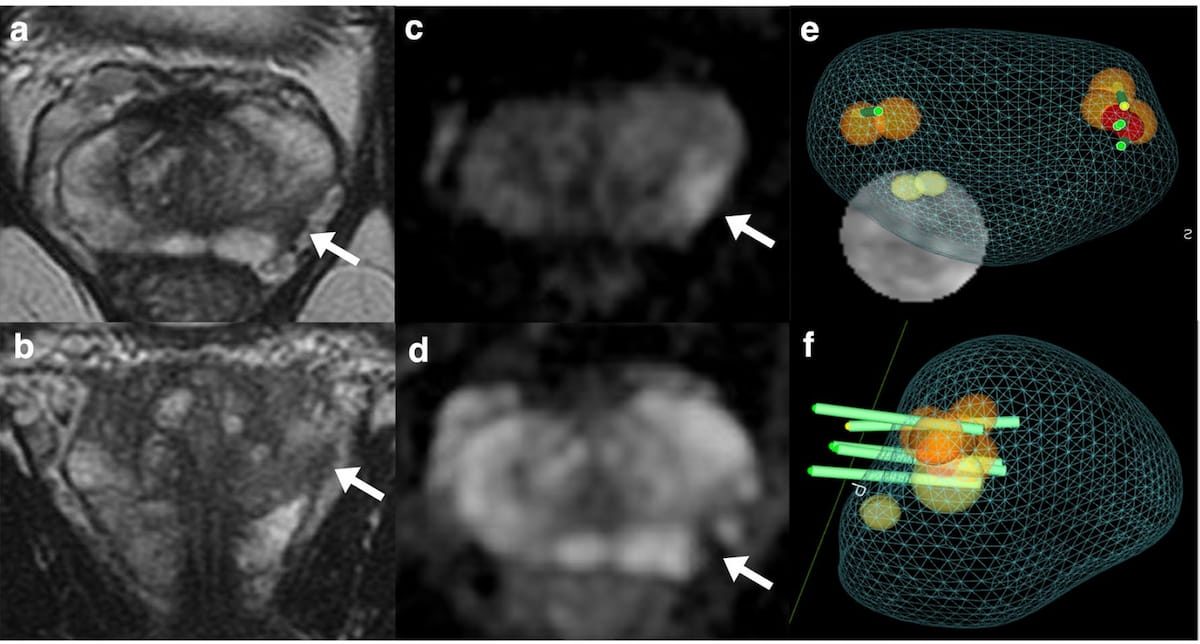Study: Abbreviated Non-Contrast MRI May Facilitate Early Detection of Prostate Cancer
The use of non-contrast, biparametric MRI (bpMRI) for prostate cancer screening regardless of PSA values detected more clinically significant cases of prostate cancer than reserving bpMRI for patients with elevated PSA levels, according to preliminary findings from an ongoing prospective, randomized study.
Could wider usage of non-contrast magnetic resonance imaging (MRI) bolster detection of clinically significant prostate cancer (csPCa) and reduce unnecessary biopsy procedures?
Noting the paradox between a reported 40 percent occurrence of overdiagnosis with a prostate-specific antigen (PSA) testing-only approach to prostate cancer screening and potential cost savings of early disease detection, researchers are currently exploring an alternative approach to prostate cancer (PCa) screening.
In an ongoing prospective randomized study, researchers are comparing one group of 175 men who had biparametric MRI (bpMRI) for prostate cancer screening regardless of PSA values to a group of 173 men in whom bpMRI was reserved only for those who had PSA values greater than 3 ng/mL or 2.5 ng/mL if they had a family history of prostate cancer. Sixty-one men in the second treatment arm had bpMRI, according to the study.
Preliminary results from the study, published in European Radiology, showed that biopsy was recommended for 11.4 percent (20/175) of the patients in the first treatment arm (bpMRI screening regardless of PSA values) in comparison to 5.2 percent (9/173) of the second treatment group (reserving bpMRI for patients with elevated PSA values). Out of 10 biopsies performed in the first group, researchers noted six cases of prostate cancer (including four cases of csPCa). Out of six biopsies performed in the second group, the study authors found two cases of clinically insignificant prostate cancer (ciPCa).
“This new approach to PCa screening could facilitate the early diagnosis of csPCa while reducing the number of unnecessary prostate biopsies and the detection of ciPCa,” wrote Valeria Panebianco, M.D., who is affiliated with the Department of Radiological Sciences, Oncology and Pathology at Sapienza University in Rome, Italy, and colleagues.
Here one can see detection of a focal nodular lesion on axial and coronal T2-weighted MRI scans (a and b) for a 50-year-old man who had normal PSA values. Subsequent MRI-targeted biopsy revealed the presence of clinically significant prostate cancer. (Images courtesy of European Radiology.)

The researchers added that four of the six men diagnosed with the PCa in the first treatment group (including three out of four men who had csPCa) had normal PSA levels.
“These men, without those screening MRIs, probably would not have been diagnosed with PCa at such an early stage,” pointed out Panebianco and colleagues.
The study authors explained that the MRI protocol included high-resolution T2-weighted imaging in axial and coronal planes as well as diffusion-weighted imaging (DWI). The mean MRI scan time in the study was 15 minutes, according to the researchers.
“Performing non-contrast MRI reduces the exam acquisition time and improves operational logistics, lowering costs and side effects,” pointed out Panebianco and colleagues. “In addition, many of the practical difficulties associated with multi-parametric MRI with contrast medium injection are removed, and this makes the execution of the examination simplified and ideally possible in a greater number of centers.”
In regard to study limitations, the researchers emphasized that the findings are preliminary data from a single tertiary referral center. They also conceded a low number of prostate cancer occurrences in both arms of the study.
New bpMRI Study Suggests AI Offers Comparable Results to Radiologists for PCa Detection
April 15th 2025Demonstrating no significant difference with radiologist detection of clinically significant prostate cancer (csPCa), a biparametric MRI-based AI model provided an 88.4 percent sensitivity rate in a recent study.
Expanded FDA Approval Allows Use of Pluvicto Prior to Chemotherapy in Patients with mCRPC
March 28th 2025Recent research demonstrated a 59 percent reduced risk of progression or death with the radioligand therapy Pluvicto in comparison to a change of androgen receptor pathway inhibitor (ARPI) for patients with metastatic castration-resistant prostate cancer (mCRPC).
Study: Monitoring of Prostate MRI Exams Could Lead to 75 Percent Reduction of Gadolinium Contrast
March 17th 2025While DCE MRI was deemed helpful in over 67 percent of cases in which it was used, researchers found that monitored prostate MRI exams, which facilitated a 75 percent reduction of DCE MRI sequences, had comparable sensitivity for prostate cancer as non-monitored exams.